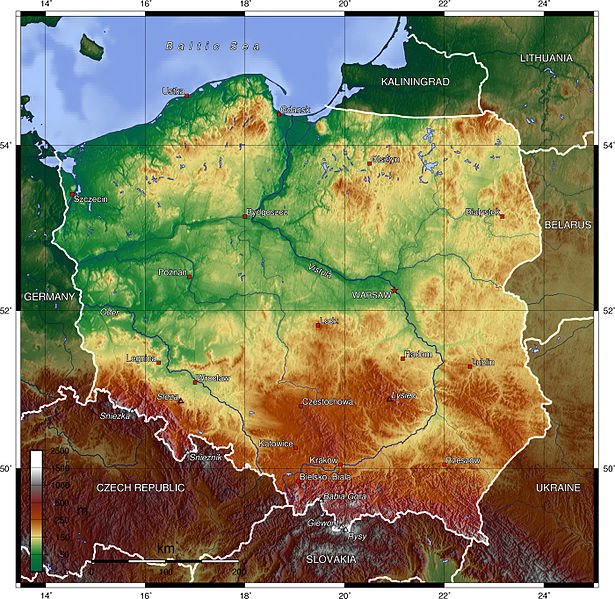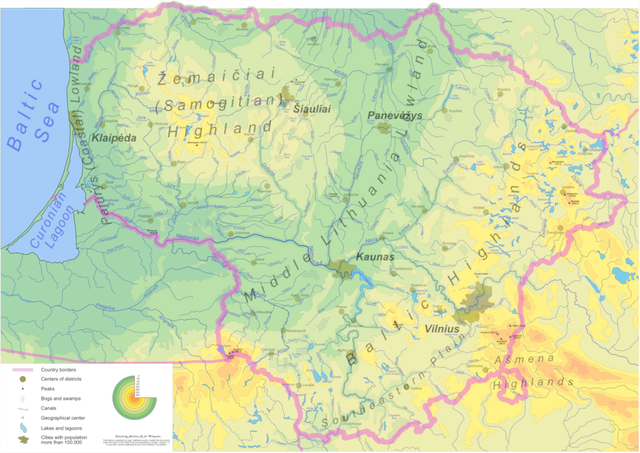INTRODUCTION TO CARTOGRAPHY - ISARITHMIC ANALYSIS
How is everything going? I sincerely hope everybody is having a good time. As we move further into the Fall season, the weather is still really hot over here, making it even harder to concentrate on one's work and stay productive. However, it is always a good chance to visit the beach and spend a couple relaxing hours. Life is good as far as I am concerned, I am just super busy; I doubt if that's ever going to change as I am a workaholic. You guessed right, I am back to provide the next part of this series, so let's waste no more time!
As promised in a previous Cartography post regarding the elements of isarithmic mapping, this is the twenty-second part of this Introduction to Cartography series. This time I am taking the chance to share broad technical information regarding the different types of errors that are generated during the isarithmic process. After making an introduction regarding the elements of isarithmic mapping, I feel like readers are now ready to learn more about how Cartographers need to follow specific rules with caution while gathering data or making crucial decisions. Bare with me as this is going to be a rather interesting read for the science lovers.
This is the point where I always include a personal note for those of you who are new to my blog; this is just an introductory series about Cartography, which is the art and science of making observations, gathering measurements and creating 2D depictions of 3D objects with precision. This means that I will be presenting general information in a simplified manner while throwing a couple failed jokes, so that nobody gets too bored while reading this. There's a high chance of learning a thing or two by reading through this blog, so stay tuned!
Symbolization Problems
As explained multiple times in my previous posts, the symbolization process is a rather complicated and difficult job that demands theoretical knowledge related to various different scientific fields. The design of the appropriate symbols that will be utilized to represent all different sorts of spatial data, and the proper selection of the most effective visual variables by taking into consideration the nature of the data being depicted, the map scale that will be utilized and the way the human sensory system works, determine the quality of the end product. Obviously, due to the fact that we are dealing with a rather complicated situation the outcome of which can be affected by multiple factors, there are various categories of errors generated.
In this blog we are going to discuss problems that refer to the different sorts of errors generated, which of course affect the precision and the quality of the information provided on a map. There are many factors that induce errors when dealing with metric information, most of which are directly related to low quality measurements or false understanding of theoretical concepts and fundamental principles. However, there are also cases where the utilization of inappropriate equipment or carelessness during the process of observation can literally downgrade the quality of our end product by generating large errors. In order to solve a problem we have to map it first, which is also what has to be done in order to track and eliminate errors as well.
Cartographers need to be able to spot and point out the specific characteristics of the factors that induce generation of large errors in the process of designing and building isarithmic maps. One of the main factors consists of the three elements of isarithmic mapping we discussed in the previous part of this series, which by the way are the number and location of control points, and the accuracy of the interpolation process. Moreover, another significant factor is the quality of the data measured and gathered, which is always of huge significance in Engineering in general. Finally, the selection of the appropriate isarithmic interval for the map plays a rather important role as well. Let's take a deeper look at the different categories of errors often generated in isarithmic maps.
Systematic Method Errors
Systematic method errors are caused by imperfect methods of observation or low quality instruments in combination with inexperienced observers. Errors that stem from the three key elements of isarithmic mapping and the process followed are such errors in our case. Those three key elements (number of control points, position of control points, and interpolation process) affect each other and therefore create a living organism which can downgrade the quality of the end product if not given the proper attention. There is a hypothetical correlation between the number of control points used and the map accuracy in a way that more control points means higher quality regarding all metric information extracted. However, we should always bare in mind that control points cost, and as a result there is a thin line between accuracy and efficiency.
Another equally significant factor is the precise location of the control points utilized. If our control points are not uniformly distributed then some areas of our projection's surface are depicted with a lot more precision regarding detail. This is one of the main reason why random distributions of the control points are never selected and Cartographers tend to use classified control points in order to achieve the same levels of accuracy across the entire map surface. This element of isarithmic mapping induces the generation of simple errors, the magnitude of which is defined by the structure of the surface used for the collection of raw data.
Last but not least, the model of the interpolation process followed for the estimation of values that refer to all points situated between control points is of huge importance as well, and therefore it can definitely affect the accuracy of an isarithmic map. Digital Cartography provides Cartographers with tools and options that enable them to use non-linear methods of interpolation in order to achieve higher accuracy, however let's keep in mind that the utilization of most of those tools requires knowledge regarding the available distribution. This can be a real problem, as Cartographers often have to overcome the obstacles induced by the unavailability of information regarding the surface variation of certain geographic entities. Of course there's always a solution, which in this case lies in the ability of a Cartographer to define the most appropriate interpolation method. Quality measurements and estimations help. Let's see why.

Quality Estimations
Any errors associated with all calculations regarding the values of the particular spatial characteristics that are being observed, measured, classified and symbolized can directly affect the (x,y) values of our control points. Even in cases where the (z) value is correct, wrong (x,y) values mean that our isarithmic lines won't be placed properly on the map's surface. This works the other way around as well, meaning that correct (x,y) values combined with wrong (z) values would still result in false placement for our isarithmic lines. Everything mentioned above is making it obvious that the level of accuracy regarding the position of control points, as well as the accuracy concerning the value (z) which refers to the spatial characteristic being studied affect the level of accuracy that can be achieved on a given statistical surface.
There are three different categories of method errors that affect the credibility of any metric information that can be represented and extracted from our map and is directly related to the spatial characteristics (z) depicted on an isarithmic map. Observation errors refer to the method of observation followed in order to gather measurements and affect the map's geometry, whereas sampling errors stem from the utilization of inappropriate methods of collecting data. Communication errors depend on the efficiency of the symbolization process and depends a lot on the Cartographer's personal decisions. I will share broad information regarding all categories of method errors in the next blog, coming out within the next few days. Thank you for being here.
Alright people, that's it for now. We have officially reached the end of another part of my beloved Introduction to Cartography series. There's still plenty of room to have some fun and plenty of time to discuss more about Cartography. Please bare with me and follow me for more, I promise this is going to be fun. Oh, in case there are any questions regarding these blogs, please do let me know in the comments below and I will do my best to provide prompt and detailed answers. More Engineering stuff regarding Cartography and Geology coming out within the next days, so stay tuned and follow me for more!
PREVIOUS PARTS OF THE SERIES:
IMAGE SOURCES:
REFERENCES:
University Textbooks & Course Lectures:
- Χαρτογραφία Ι/ Cartography I -TSOULOS(National Technical University of Athens, School of Rural & Surveying Engineering, Course Lecture Notes)
Internet Links:
http://www.geog.ucsb.edu/~kclarke/Geography183/Lecture11.pdf
https://help.rockware.com/rockworks17/WebHelp/maps_2d_symbols.htm
https://prism.ucalgary.ca/bitstream/handle/1880/45758/2001-693-16.pdf?sequence=2&isAllowed=y





Damned! I have missed a lot of your posts! And this one was indeed an interesting read for the science lover I am. Anything you actually described can be associated as well to any interpolation process. The post is thus much more general, somehow! :)
Hey @lemouth, thanks for stopping by!
I am glad and honored you took the time to read another blog of mine! And yes you are absolutely right, the interpolation process tips mentioned are general, only non-linear methods of interpolation are not so popular among most scientific fields! Thanks for passing by, your comment put a smile on my face.
Have a great day!
Yeah, we are often very linear. Or logarithmic. Both are used a lot.
Κανα τοπογραφικο κανεις ή εισαι μονο θεωρια ???
Κλαίω!
Εγω παντως σοβαρα μιλαω...
Γιατί, ενδιαφέρεσαι για τις υπηρεσίες μου ή θες να με προσλάβεις;; Το ''
η είσαι μόνο θεωρία'' δεν μου φάνηκε σοβαρή ερώτηση, Ηλία.
Οκ στο δινω , αλλα πραγματικα θα ηθελα να ξερω αν μπορεις να κανεις τοπογραφικα. Αν προκυψει κατι να σε εχω υποψη.
Η αλήθεια είναι ότι κάνω τοπογραφικά από το '12, αλλά δεν είναι κάτι που θα με ενδιέφερε να κάνω πλέον. Ευχαριστώ πάντως!
ok. νασαι καλα :)
Επίσης να σε ενημερώσω ότι τα τοπογραφικά διαγράμματα σχετίζονται με την Γεωδαισία, αλλά πάντα υπάρχει μια σύνδεση πεδίων και μπορούμε να τα συζητήσουμε αν θες. :)
Καλά!!!! έμεινα με το στόμα ανοικτό!!! τι έγραψε ο παίκτης παλι!!!!! τέλειο!!!
καλό βράδυ.... :)
Να 'σαι καλά Nick, σε ευχαριστώ πολύ!
Καλό βράδυ!
This post has been voted on by the steemstem curation team and voting trail.
There is more to SteemSTEM than just writing posts, check here for some more tips on being a community member. You can also join our discord here to get to know the rest of the community!
Thanks for the constant support, it means a lot to me!
Hi @lordneroo!
Your post was upvoted by utopian.io in cooperation with steemstem - supporting knowledge, innovation and technological advancement on the Steem Blockchain.
Contribute to Open Source with utopian.io
Learn how to contribute on our website and join the new open source economy.
Want to chat? Join the Utopian Community on Discord https://discord.gg/h52nFrV
Thank you so much for all the support I've been receiving!
Hi @lordneroo!
Your post was upvoted by @steem-ua, new Steem dApp, using UserAuthority for algorithmic post curation!
Your UA account score is currently 3.798 which ranks you at #4458 across all Steem accounts.
Your rank has improved 23 places in the last three days (old rank 4481).
In our last Algorithmic Curation Round, consisting of 188 contributions, your post is ranked at #22.
Evaluation of your UA score:
Feel free to join our @steem-ua Discord server